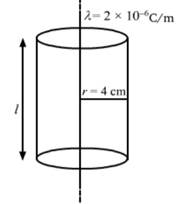Find the magnitude of the electric field at a point 4 cm away from a line charge of density 2 × 10–6 C m–1.
Given:
Charge density of line charge=2× 10-6C/m=λ
Distance of point from line charge=4cm=4× 10-2m=r

Consider a Gaussian cylindrical surface around the line charge of radius 4cm and height l.
All the points on the curved part of this gaussian surface are at the same perpendicular distance from the line charge. Therefore all these points are equivalent. The electric field at all these points will have the same magnitude E and direction of field at any point on the curved surface is normal to the line and hence normal to the cylindrical surface.
By Gauss’s law, flux of net electric field through a closed surface equals the net charge enclosed by the surface divided by ϵ0
![]() …(i)
…(i)
Through the circular faces at the top and bottom the angle between electric field and area vector is 90° therefore flux through these surfaces is zero.
By applying gauss’s law for the curved cylindrical surface,
![]()
Where E⃗=electric field vector
dS⃗ =area of differential surface element
qin=charge enclosed by Gaussian surface
curved surface area of cylinder=2πrl
flux through the curved part is given by
![]()
The total flux through the gaussian surface is given by 2πrl
The charge enclosed by the gaussian surface is ( line charge density × height of cylindrical surface )
⇒ λ × l
Using gauss’s law(i)
![]()
∴ ![]()
⇒ ![]() N/C (putting the values of λ ,r,π and ϵ0)
N/C (putting the values of λ ,r,π and ϵ0)
⇒ ![]() N/C
N/C
Therefore the magnitude of electric field at a distance 4cm away from the line charge is given by 8.99× 105N/C